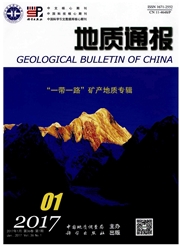

 中文摘要:
中文摘要:
慕士塔格岩体是西昆仑造山带出露面积最大的侵入岩体,主要由石英二长岩、花岗闪长岩和二长花岗岩组成。岩石地球化学特征显示,该岩体具有较高的Si02含量和碱度率,低的Al2O3、Fe2O3、MgO、P2O5,稀土元素总量较低,总体上轻重稀土元素分馏明显,富集Rb、Th、K和LREE等大离子亲石元素,亏损Nb、Ta、Sr、P、Ti和HREE等高场强元素,应为高钾钙碱性准铝质-弱过铝质岩石,属于未分异I型-分异I型花岗岩。通过对源岩性质、成因和构造环境的研究,结合区域地质资料,认为该岩体是古特提斯后碰撞伸展环境下,在高温(〉839.6℃)低压(〈15kbar)N境中壳源变玄武岩发生部分熔融,并伴随着幔源岩浆的参与.经历了以斜长石、磷灰石和钛铁矿为主的分离结晶作用的产物。
 英文摘要:
英文摘要:
The Muztagata pluton, the largest granitic intrusion in Western Kunhin orogenic belt, is composed of quartz monzonite, granodiorite and monzonitic granite. The intrusion is characterized by high SiO2 and alkali, low Al2O3, Fe2O3, MgO, P2O5 and ∑REE, enrichment of LILE (Rb, Th, K, LR.EE), and depletion of HFSE (Nb, Ta, Sr, P, Ti, HREE). The intrusion can thus be classified as the high-K calc-alkaline series with metahiminous to slightly perahiminous features, belonging to undifferentiated and fractionated I- type granite. Based on a comprehensive analysis of the source region as well as genetic process and tectonic setting of this intrusion, in combination with the regional geological data, it is held that Muztagata intrusion was most likely derived from partial melting of basaltic rocks in the lower crust under the condition of high temperature (〉839.6℃) and low pressure (〈15kbar) in the transitional pe- riod from primary collision to post-collision, and subsequently it underwent the crystallization of plagioclase, apatite and ilmenite to- gether with the injection of mantle-derived magma. In addition, the Western Kunlun granites had the evolutionary characteristic of conversion from I-type to A-type granite during the post-collision of Paleo-Tethys.
 同期刊论文项目
同期刊论文项目
 同项目期刊论文
同项目期刊论文
 期刊信息
期刊信息
